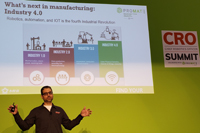CRO Session: Bobbys and Bettys to the Rescue

 ProMat 2019 includes collocated sessions of the Chief Robotics Officer (CRO) Summit presented by Robotics Business Review. Conference sessions focus on automation, AI, robotics and the latest intelligent technologies for supply chain operations. Sessions are taking place in the North Hall all day today!
ProMat 2019 includes collocated sessions of the Chief Robotics Officer (CRO) Summit presented by Robotics Business Review. Conference sessions focus on automation, AI, robotics and the latest intelligent technologies for supply chain operations. Sessions are taking place in the North Hall all day today!
If you are not on the bus with industry 4.0, then you are under the bus,” was how Jason Walker, CEO and Co-founder of Waypoint Robotics started off the seminar, The Workforce: Design for Them or Fail at Industry 4.0, held in the RoboBusiness Theater on Tuesday. “You will be so inefficient you will be uncompetitive.”
Not an ideal position for a small- or mid-sized company, yet many are occupying it as they “have been left behind with the automation boom,” explained Walker. But it doesn’t have to remain this way. “We think making automation and robotics more accessible to more people is the solution,” said Walker. “And we want to make sure people are included in the Industry 4.0 revolution, too.”
Why are people important in a robotics revolution, you might ask? Walker said they’ve figured it out, and it is the Bobby (or Betty) First philosophy. “Bobby is the person who has been at the factory for 20 years,” said Walker. He knows his job backward and forward, and everyone loves Bobby. “Our approach is to make a robot that the Bobbys of the world can use. If you can empower the people who have been doing that all along…. it is going to be better for everyone in the long run.” Also, empowering the Bobbys to make decisions means that you are, essentially, enabling your robots to be “nail-guns instead of hammers.” The workforce should expect more from their robots, added Walker.
One memorable example Walker shared had to do with rebuilding automatic transmissions. The technicians involved in this “incredibly complicated, brain-intensive job” of doing the actual rebuilding were also being tasked with moving the 300-pound completed piece to a different location once they were done – a process that was physically demanding, time-consuming and “intellectually frustrating.” In this case, the idea of bringing on robots to perform this aspect of the job not only made all the current technicians ecstatic, it had to possibility of being used to attract additional qualified talent as well. “If workers have to do this at one company and not the other, which one is going to win that technician?” asked Walker.
In a nutshell, said Walker, “robotics companies should design for the workforce and chief robotics officers (CROs) should buy products designed for the workforce.”

 ProMat 2019 includes collocated sessions of the Chief Robotics Officer (CRO) Summit presented by Robotics Business Review. Conference sessions focus on automation, AI, robotics and the latest intelligent technologies for supply chain operations. Sessions are taking place in the North Hall all day today!
ProMat 2019 includes collocated sessions of the Chief Robotics Officer (CRO) Summit presented by Robotics Business Review. Conference sessions focus on automation, AI, robotics and the latest intelligent technologies for supply chain operations. Sessions are taking place in the North Hall all day today!